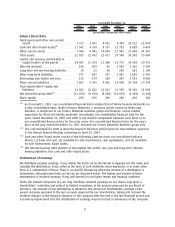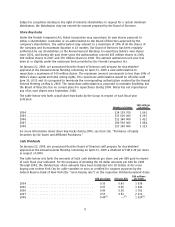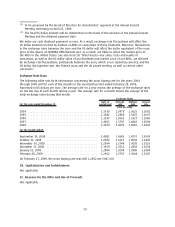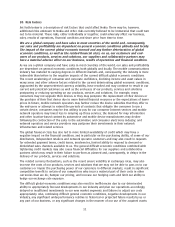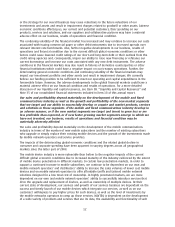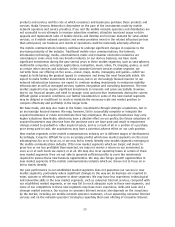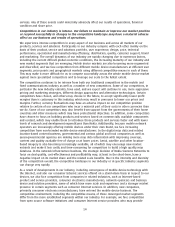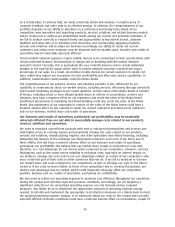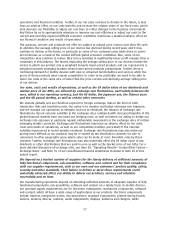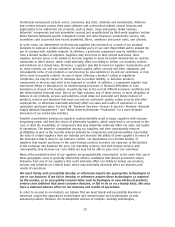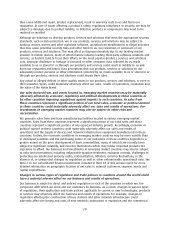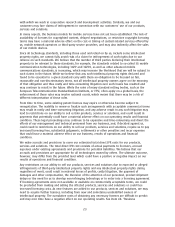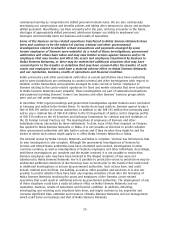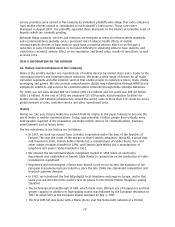Nokia 2008 Annual Report Download - page 19
Download and view the complete annual report
Please find page 19 of the 2008 Nokia annual report below. You can navigate through the pages in the report by either clicking on the pages listed below, or by using the keyword search tool below to find specific information within the annual report.mechanical components include covers, connectors, key mats, antennas and mechanisms. Software
and content includes various thirdparty software and content that enables various features and
applications to be added into our products, such as music, maps and games. Nokia Siemens
Networks’ components and subassemblies sourced and manufactured by thirdparty suppliers include
Nokia Siemens Networksspecific integrated circuits and radio frequency components; servers; sub
assemblies such as printed wire board assemblies, filters, combiners and power units; and cabinets.
In some cases, our dependence on thirdparty suppliers has increased as a result of our strategic
decisions to outsource certain activities, for example parts of our own chipset R&D and to expand the
use of commercially available chipsets. In addition, a particular component may be available only
from a limited number of suppliers. Suppliers may from time to time extend lead times, limit
supplies, increase prices or be unable to increase supplies to meet increased demand due to capacity
constraints or other factors, which could adversely affect our ability to deliver our products, services
and solutions on a timely basis. Moreover, a supplier may fail to meet our supplier requirements, such
as, most notably, our and our customers’ product quality, safety, security and other standards, and
consequently some of our products or services may be unacceptable to us and our customers, or may
fail to meet our quality controls. In case of issues affecting a product’s safety or regulatory
compliance, we may be subject to damages due to product liability, or defective products,
components or services may need to be replaced or recalled. In addition, a component supplier may
experience delays or disruption to its manufacturing processes or financial difficulties or even
insolvency or closure of its business, in particular due to the current difficult economic conditions and
the related global financial crisis. Due to our high volumes, any of these events, or mere allegation of
failures in our products, services and solutions, could delay our successful and timely delivery of
products, services and solutions that meet our and our customers’ quality, safety, security and other
requirements, or otherwise materially adversely affect our sales and results of operations or our
reputation and brand value. See Item 4B. “Business Overview—Devices & Services—Markets—Demand
Supply Network Management ” and “Nokia Siemens Networks—Production” for a more detailed
discussion of our production activities.
Possible consolidation among our suppliers could potentially result in larger suppliers with stronger
bargaining power and limit the choice of alternative suppliers, which could lead to an increase in the
cost, or limit the availability, of components that may materially adversely affect our sales and results
of operations. The intensive competition among our suppliers and their consequently reduced
profitability as well as the recently reduced demand for components and subassemblies may further
the exits of certain suppliers from our industry and decrease the ability of some suppliers to invest in
the innovation that is vital for our business. Further, our dependence on a limited number of
suppliers that require purchases in the same foreign currency increases our exposure to fluctuations
in the exchange rate between the euro, our reporting currency, and such foreign currency and,
consequently, may increase our costs which we may not be able to pass on to our customers.
Many of the production sites of our suppliers are geographically concentrated. In the event that any of
these geographic areas is generally affected by adverse conditions that disrupt production and/or
deliveries from any of our suppliers, this could adversely affect our ability to deliver our products,
services and solutions on a timely basis, which may materially adversely affect our business and
results of operations.
We must timely and successfully develop or otherwise acquire the appropriate technologies to
use in our business. If we fail to develop or otherwise acquire these technologies as required
by the market, or to successfully commercialize such technologies as new advanced products,
services and solutions that meet customer demand, or fail to do so on a timely basis, this may
have a material adverse effect on our business and results of operations.
In order to succeed in our markets, we believe that we must timely and successfully develop or
otherwise acquire the appropriate technologies and commercialize such technologies as new
advanced products. However, the development and use of complex, evolving technologies,
18


